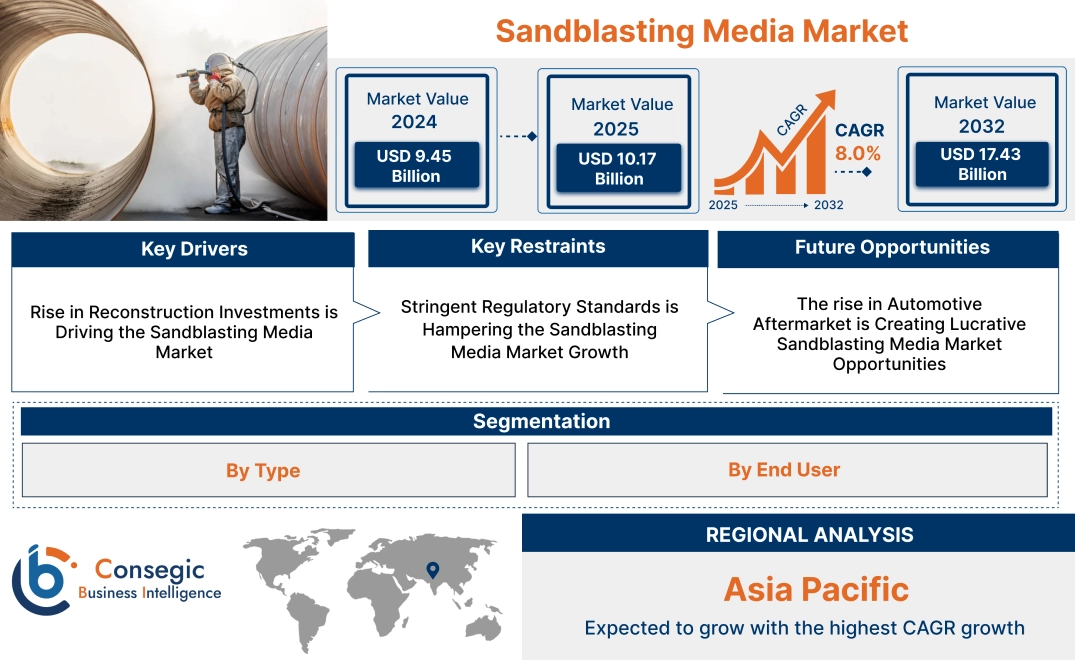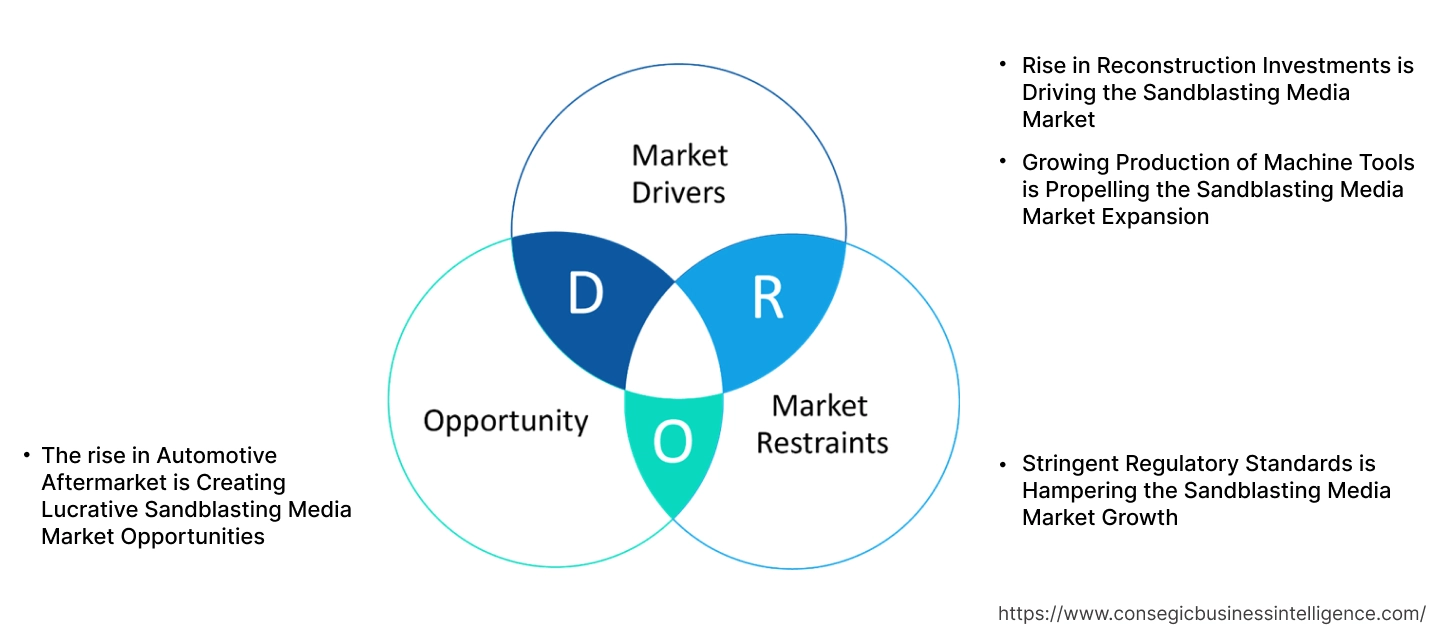- Summary
- Table Of Content
- Methodology
Sandblasting Media Market Size:
Sandblasting Media Market size is growing with a CAGR of 8.0% during the forecast period (2025-2032), and the market is projected to be valued at USD 17.43 Billion by 2032 from USD 9.45 Billion in 2024. Additionally, the market value for the 2025 attributes to USD 10.17 Billion.
Sandblasting Media Market Scope & Overview:
Sandblasting media encompasses a diverse range of abrasive materials propelled at high velocity to clean, shape, or modify a surface. Primarily utilized for surface preparation, this process effectively eliminates rust, scale, old paint, and other unwanted contaminants, creating a clean and keyed substrate ideal for subsequent operations like painting, priming, and welding, thereby ensuring proper adhesion and longevity of applied coatings. Beyond preparation, sandblasting is also employed for thorough cleaning, rapidly removing surface pollutants without compromising the integrity of the underlying material. The types of sandblasting media generally consist of aluminum oxide, crushed glass, glass beads, plastic blasting media, silicon carbide, pumice, steel grit, and others. The end-use generally consists of metalworking, construction, automotive, aerospace, marine, and others.
Key Drivers:
Rise in Reconstruction Investments is Driving the Sandblasting Media Market
As infrastructure ages and requires refurbishment, sandblasting becomes crucial for removing deteriorated materials like old coatings, rust, and corrosion from surfaces such as bridges, buildings, and pipelines. This process prepares the underlying substrate for necessary repairs and the application of new protective layers, ensuring the longevity and safety of the reconstructed structures. Furthermore, in historical restoration projects, specialized and gentler sandblasting techniques are employed to carefully clean and preserve delicate original materials, contributing to the requirement for specific types of media. The rise in investment for infrastructure modernization and the preservation of historical assets directly translates to a greater need for effective and appropriate sandblasting media.
For instance,
- In 2023, the Biden-Harris Administration's allocation of nearly USD 300 Million towards nine bridge projects, as a core component of the Investing in America agenda, signifies a substantial commitment to modernizing critical infrastructure.
Thus, the rise in the restoration projects is influencing the growth of the market.
Growing Production of Machine Tools is Propelling the Sandblasting Media Market Expansion.
In machine tool production, sandblasting is a vital step for precisely preparing component surfaces. By effectively removing scales, rust, and other manufacturing imperfections, it establishes a clean and properly textured foundation. This optimized surface ensures superior adhesion for subsequent painting, coating, or other critical finishing processes, ultimately contributing to the enhanced durability, performance, and longevity of the final machine tool. The rise in production volume necessitates a corresponding increase in the consumption of sandblasting media to meet these surface treatment requirements in the machine tool manufacturing sector.
For instance,
- According to the data published by the CECIMO, the rise in machine tools production has seen an increase of 19.7% in 2022.
Thus, the rise in the production of machine tools is influencing the rise in the use of this media specifically for surface treatment applications.
Key Restraints:
Stringent Regulatory Standards is Hampering the Sandblasting Media Market Growth
The Sandblasting Media industry faces significant hurdles due to stringent regulatory standards imposed by various regulatory bodies worldwide. These regulations, mainly implemented by environmental and health agencies, aim to control dust emissions, manage waste disposal, and restrict the use of hazardous materials like silica sand due to the risk of silicosis and other respiratory illnesses. Compliance with these standards is time-consuming and costly, particularly for smaller companies or those developing novel ingredients.
Additionally, changes in regulatory guidelines or the introduction of stricter regulations disrupt established processes and require significant investments in research, development, and manufacturing to meet the new standards. These factors contribute to increased costs, delayed product launches, and limited market access, ultimately hindering the development of the market.
Future Opportunities :
The rise in Automotive Aftermarket is Creating Lucrative Sandblasting Media Market Opportunities.
The rise in the automotive aftermarket, which encompasses the repair, maintenance, and customization of vehicles after their initial sale, is creating significant opportunities for the market. As vehicles age, components like wheels, body panels, and engine parts often require refurbishment due to rust, corrosion, or old paint. Sandblasting is a highly effective method for removing these imperfections and preparing the surfaces for refinishing, repainting, or the application of protective coatings. The increasing trend of vehicle restoration, customization, and the general need for vehicle maintenance within the aftermarket influences the requirement for various types of sandblasting media, from aggressive abrasives for rust removal to gentler options for paint stripping on delicate surfaces.
For instance,
- The data by Autocare states that, the United States light-duty automotive aftermarket experienced substantial expansion with an 8.6% growth in 2023, and projections indicate continued robust growth of 5.9% for the light vehicle aftermarket heading towards 2027.
Therefore, the expanding automotive aftermarket directly fuels a growing requirement and creates lucrative sandblasting media market opportunities.
Sandblasting Media Market Segmental Analysis :
By Type :
Based on the type, the market is segmented into aluminum oxide, crushed glass, glass beads, plastic blasting media, silicon carbide, pumice, steel grit, and others.
Trends in the Type:
- The growing trend for tailored surface finishes and enhanced removal rates for different applications and materials is influencing the use of aluminum oxide.
- The rise in the trend for compounds that quickly and efficiently remove tough coatings, rust, and scale is influencing the use of silicon carbide.
The aluminum oxide segment accounted for the largest market share in 2024.
- Aluminum oxide stands out as a highly effective and widely utilized sandblasting solution due to its exceptional hardness.
- This allows for the rapid removal of tough contaminants like rust, scale, and coatings from various surfaces, including metals, ceramics, and composites.
- Its angular grain shape ensures efficient material abrasion and the development of an ideal surface profile for subsequent painting or bonding.
- Available in diverse hardness grades and grit sizes, it offers versatility for a wide spectrum of project requirements.
- Additionally, the use of aluminum oxide in aerospace improves the durability of and surface finish.
- For instance, the data in the Jiangsu Henglihong Technology Co., Ltd blog suggests that after using ultrafine aluminum oxide blasting to treat the blade surface, without damaging the substrate, the blade’s durability is improved by 10% to 15%, and the surface finish is improved by 15% to 20%.
- Thus, these factors are influencing the growth of the segment.
The silicon carbide segment is expected to grow at the fastest CAGR over the forecast period.
- As the hardest commonly utilized blasting media, silicon carbide delivers exceptionally rapid cutting action.
- Starting as small, durable blocks, it breaks into sharp, highly effective particles during blasting, ensuring swift removal of even stubborn contaminants like heavy rust.
- Notably, silicon carbide offers superior recyclability, making it an economically and environmentally sound choice for multiple reuses.
- Its aggressive yet controllable abrasive properties make it ideal for intricate etching on stone and glass, as well as for demanding surface preparation tasks across various industrial applications where speed and effectiveness are paramount.
- Thus, the growing utilization of naturally sourced ingredients is influencing the Sandblasting Media market demand in the coming years.
By End User:
Based on the end user, the market is categorized into metalworking, construction, automotive, aerospace, marine, and others.
Trends in end user:
- There is a rise in trends for the maintenance and repair of metal machinery and structures, which influences the use of various sandblasting solutions.
- The robust rise of the automotive aftermarket, driven by vehicle aging, restoration projects, and customization trends, is significantly increasing the demand for various sandblasting compounds.
The metalworking segment accounted for the largest Sandblasting Media market share of 36.77% in the year 2024.
- The metalworking industry stands as a significant and consistent end-user of sandblasting compounds, integrating this surface treatment technique across various stages of metal processing and product lifecycle.
- During the initial manufacturing of metal components and products, sandblasting is a crucial step for preparing raw metal surfaces by effectively removing mill scales, rust, and other impurities that impede subsequent processes like welding, machining, and coating.
- Furthermore, in metal fabrication and repair operations, sandblasting plays a vital role in preparing metal surfaces for repair, refurbishment, or the application of new protective layers, thereby extending the lifespan of metal structures and machinery.
- The rise in metal processing and production is influencing the rise in fabrication businesses.
- For instance, the data by DVIRC states that metal fabrication is one of the largest manufacturing sectors in Pennsylvania, representing over 4,000 total facilities.
- Therefore, the increasing activity in metal processing and production directly fuels the demand for sandblasting compounds across a wide range of metal fabrication businesses, thus driving the sandblasting media market expansion.
The automotive segment is expected to grow at the fastest CAGR over the forecast period.
- The rising global vehicle production, coupled with the expanding automotive aftermarket for repair, maintenance, and customization, fuels a significant requirement for surface preparation.
- Sandblasting is crucial in removing rust, corrosion, and old paint from vehicle bodies, parts, and wheels, preparing them for refinishing and ensuring the longevity and aesthetic appeal of vehicles.
- Furthermore, the automotive sector's stringent quality standards for coatings and finishes necessitate effective and reliable abrasive blasting processes, driving the consumption of various sandblasting compounds tailored to specific materials and applications.
- Thus, as per the market analysis, the aforementioned factors are driving the sandblasting media market growth in the coming years.
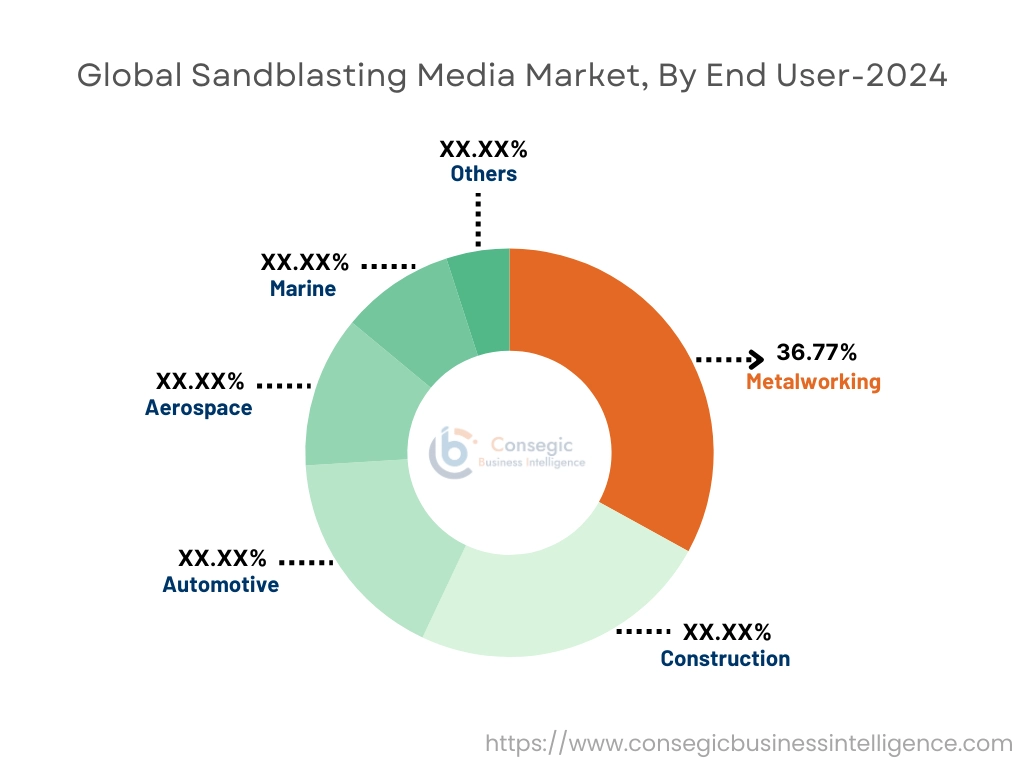
Regional Analysis:
The regional segment includes North America, Europe, Asia Pacific, the Middle East and Africa, and Latin America.
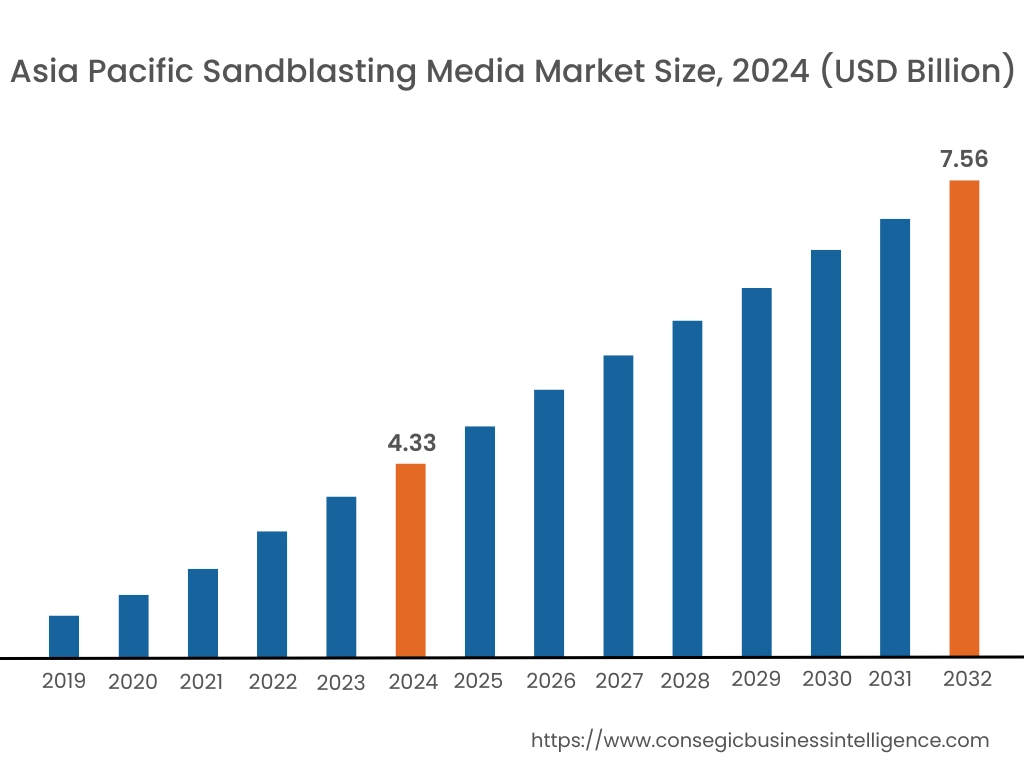
In 2024, Asia Pacific accounted for the highest sandblasting media market share at 45.78% and was valued at USD 4.33 billion and is expected to reach USD 7.56 Billion in 2032. In Asia Pacific, China accounted for the highest market share of 36.35% during the base year of 2024. Aging infrastructure, including bridges, buildings, and historical monuments, requires extensive surface preparation to remove corrosion, deteriorated coatings, and accumulated grime before repairs or new finishes are applied. Projects focused on modernizing urban areas and preserving historical landmarks utilize sandblasting for tasks ranging from heavy-duty rust removal on steel structures to delicate cleaning of fragile facades. Furthermore, the increasing investment in infrastructure upgrades and the emphasis on preserving architectural heritage across India and China are creating a sustained need for a diverse range of abrasive media.
For instance,
- In 2024, according to the data published in Invest India, USD 402.37 million is allocated to the Andhra Pradesh Roads and Bridges Reconstruction Project, a major initiative to upgrade the state's transportation network, which requires extensive surface preparation on existing roads and numerous bridges.
Thus, as per the market analysis, the rise in restoration activities in North America is influencing the sandblasting media market trends in this region.
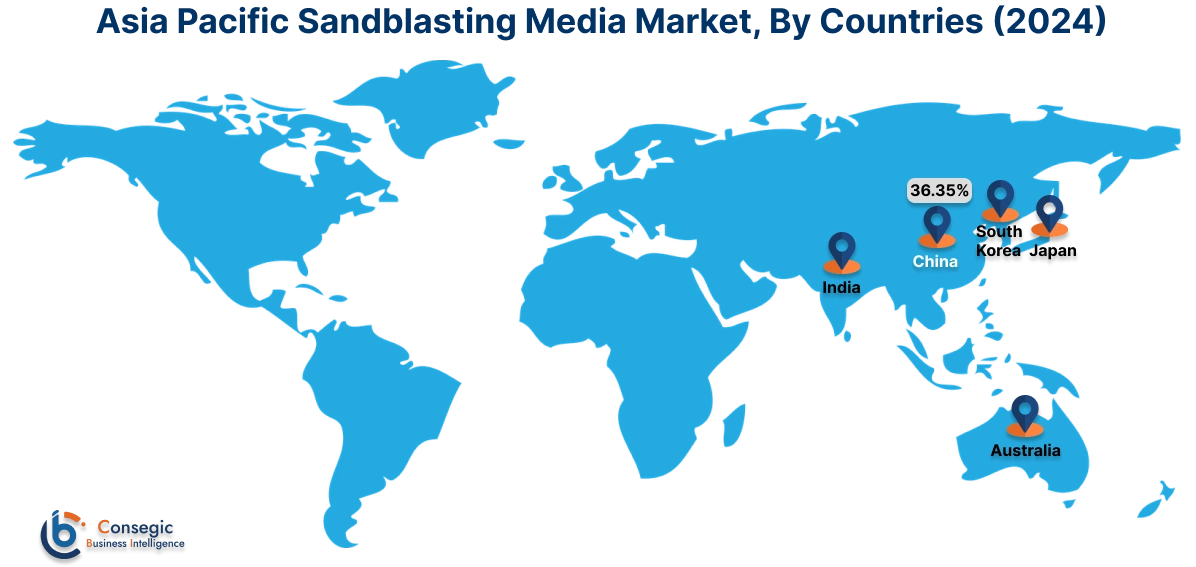
Europe is experiencing the fastest growth with a CAGR of 9.8% over the forecast period. The automotive industry in the Europe region, encompassing both vehicle manufacturing and a significant aftermarket, is a substantial consumer of sandblasting compounds. In manufacturing, sandblasting is essential for preparing vehicle components for painting and coating, ensuring proper adhesion and a high-quality finish required by both domestic and international markets. Thus, as per the sandblasting media market analysis, the rapidly expanding automotive aftermarket in the region, fueled by a growing vehicle fleet and increasing demand for maintenance, repair, and customization, further influences the need for sandblasting.
The metalworking and fabrication sectors in North America represent a significant and established market for sandblasting media. In the initial stages of manufacturing metal components, sandblasting is critical for removing mill scale, rust, and other impurities from raw materials, ensuring a clean and properly profiled surface for subsequent welding, machining, and coating applications. Furthermore, the robust metal fabrication and repair industries in the North America region utilize sandblasting extensively for tasks such as removing corrosion, old paint, and weld spatter from metal structures and equipment, preparing them for refurbishment or the application of new protective coatings. Thus, as per the market analysis, the requirement for sandblasting in metalwork is driving the sandblasting media market demand in this region.
The aerospace sector in the Middle East and Africa (MEA) is a growing sector, driven by increasing air traffic, infrastructure development, and a focus on maintenance, repair, and overhaul (MRO) activities. Sandblasting plays a crucial role in this sector for various applications. It is used for surface preparation of aircraft components before painting and coating, ensuring proper adhesion and corrosion resistance, vital for safety and longevity in harsh environmental conditions prevalent in parts of the region. Furthermore, sandblasting is employed in the MRO sector for removing old paint, corrosion, and other contaminants from aircraft structures and engine parts during maintenance and repair processes. Thus, as per the sandblasting media market analysis, these factors are influencing the rise in the market share in this region.
In Latin America's marine sector, sandblasting is a crucial technique for maintaining and repairing vessels and coastal infrastructure. The region's extensive coastlines and active fishing, shipping, and tourism industries necessitate effective methods for removing marine growth like barnacles, rust, and old paint from ship hulls, docks, and other maritime structures. This surface preparation is essential for preventing corrosion, improving vessel efficiency by reducing drag, and ensuring the longevity of protective coatings applied to withstand the harsh saltwater environment. Thus, as per the market analysis, the use of effective compounds for marine equipment is influencing the sandblasting media market trends in this region.
Top Key Players and Market Share Insights:
The global Sandblasting Media market is highly competitive with major players providing precise products to the national and international markets. Key players are adopting several strategies in research and development (R&D) and product innovation to hold a strong position in the global Sandblasting Media market. Key players in the Sandblasting Media industry include-
- Cyclone Manufacturing (Canada)
- Sandblast Equipment Manufacturers (United States)
- Kramer Industries Inc (United States)
- Opta Group (Canada)
- Paul Auer GmbH (Germany)
- Kleen Blast (United States)
- Henkel Hellas (Germany)
- Saint Gobain (France)
- Jiangsu Henglihong Technology Co., Ltd (China)
- GMA Garnet Pty Ltd (Australia)
Sandblasting Media Market Report Insights:
| Report Attributes | Report Details |
| Study Timeline | 2019-2032 |
| Market Size in 2032 | USD 17.43 Billion |
| CAGR (2025-2032) | 8.0% |
| By Type |
|
| By End User |
|
| By Region |
|
| Key Players |
|
| North America | U.S. Canada Mexico |
| Europe | U.K. Germany France Spain Italy Russia Benelux Rest of Europe |
| APAC | China South Korea Japan India Australia ASEAN Rest of Asia-Pacific |
| Middle East and Africa | GCC Turkey South Africa Rest of MEA |
| LATAM | Brazil Argentina Chile Rest of LATAM |
| Report Coverage |
|
Key Questions Answered in the Report
How big is the Sandblasting Media market? +
In 2024, the Sandblasting Media market is USD 9.45 Billion.
Which is the fastest-growing region in the Sandblasting Media market? +
Europe is the fastest-growing region in the Sandblasting Media market.
What specific segmentation details are covered in the Sandblasting Media market? +
Type and End User segmentation details are covered in the Sandblasting Media market.
Who are the major players in the Sandblasting Media market? +
Cyclone Manufacturing (Canada), Sandblast Equipment Manufacturers (United States), and Kleen Blast, (United States) are some of the major players in the market.
